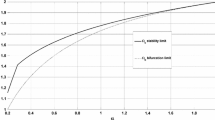Abstract
A semi-analytical method is developed based on conventional integrating factor (IF) and exponential time differencing (ETD) schemes for stiff problems. The latter means that there exists a thin layer with a large variation in their solutions. The occurrence of this stiff layer is due to the multiplication of a very small parameter \(\varepsilon \) with the transient term of the equation. Via singular perturbation analysis, an analytic approximation of the stiff layer, which is called a corrector, is sought for and embedded into the IF and ETD methods. These new schemes are then used to approximate the non-stiff part of the solution. Since the stiff part is resolved analytically by the corrector, the new method outperforms the conventional ones in terms of accuracy. In this paper, we apply our new method for both problems of ordinary differential equations and some partial differential equations.










Similar content being viewed by others
References
Ascher, U.M., Ruuth, S.J., Wetton, B.T.R.: Implicit-explicit methods for time-dependent partial differential equations. SIAM J. Numer. Anal. 32(3), 797–823 (1995)
Ascher, U.M., Ruuth, S.J., Spiteri, R.J.: Implicit-explicit Runge-Kutta methods for time-dependent partial differential equations. Appl. Numer. Math. 25(2–3), 151–167 (1997)
Ashi, H.: Numerical methods for stiff systems, Ph.D. thesis, the University of Nottingham (2008)
Aziz, et al. Z.A.: Fourth-order time stepping for stiff PDEs via integrating factor. Adv. Sci. Lett. 19(1), 170–173 (2013)
Boyd, J.P.: Chebyshev and Fourier Spectral Methods. Dover, Mineola, NY (2001)
Cash, J.R.: Efficient numerical methods for the solution of stiff initial-value problems and differential algebraic equations. Proc. R. Soc. Lond. A. 459, 797–815 (2003)
Canuto, C., Hussaini, M.Y., Quarteroni, A., Zang, T.A.: Spectral Methods in Fluid Dynamics. Springer Series in Computational Physics. Springer, Berlin (1988)
Cox, S.M., Matthews, P.C.: Exponential time differencing for stiff systems. J. Comput. Phys. 176, 430–455 (2002)
Weinan, E., Engquist, Bjorn, Li, Xiantao, Ren, Weiqing, Vanden-Eijnden, Eric: The heterogeneous multiscale method: a review. Commun. Comput. Phys. 2(3), 367–450 (2007)
Engquist, B., Tsai, Y.-H.: Heterogeneous multiscale methods for stiff ordinary differential equations. Math. Comput. 74(252), 1707–1742 (2005)
Fornberg, B.: A Practical Guide to Pseudospectral Methods. Cambridge University Press, Cambridge, UK (1996)
Holmes, M.H.: Introduction to Perturbation Methods. Springer, New York (1995)
Han, H., Kellogg, R. B.: A method of enriched subspaces for the numerical solution of a parabolic singular perturbation problem. In: Computational and Asymptotic Methods for Boundary and Interior Layers, Boole Press Conf. Ser. 4, Dublin, pp. 46–52 (1982)
Hyman, J.M., Nicolaenko, B.: The Kuramoto-Sivashinsky equation: a bridge between PDE’s and dynamical systems. Physica D 18, 113–126 (1986). North-Holland, Amsterdam
Hoz, F.D.L., Vadillo, F.: An exponential time differencing method for the nonlinear Schrödinger equation. Comput. Phys. Commun. 179, 449–456 (2008)
Hairer, E., Wanner, G.: Solving Ordinary Differential Equations II, Stiff and Differential-Algebraic Problems. Springer, Berlin (1996)
Johnson, R.S.: Singular Perturbation Theory. Springer Science+Business Media Inc, New York (2005)
Jung, C.: Finite elements scheme in enriched subspaces for singularly perturbed reaction-diffusion problems on a square domain. Asymptot. Anal. 57, 41–69 (2008)
Jin, S., Levermore, C.D.: Numerical schemes for hyperbolic conservation laws with stiff relaxation terms. J. Comput. Phys. 126, 449–467 (1996)
Jung, C., Nguyen, T.B.: Semi-analytical numerical methods for convection-dominated problems with turning points. Int. J. Numer. Anal. Model. 10(2), 314–332 (2013)
Jung, C., Nguyen, T.B.: New time differencing methods for spectral methods (submitted)
Jung, C., Temam, R.: Asymptotic analysis for singularly perturbed convection-diffusion equations with a turning point. J. Math. Phys. 48, 065301 (2007)
Jung, C., Temam, R.: Finite volume approximation of one-dimensional stiff convection-diffusion equations. J. Sci. Comput. 41(3), 384–410 (2009)
Jin, S., Xin, Z.: The relaxation schemes for systems of conservation laws in arbitrary space dimensions. Commun. Pure Appl. Math. 48(3), 235–276 (1995)
Kevorkian, J., Cole, J.D.: Multiple Scale and Singular Perturbation Methods. Springer, Berlin (1996)
Kellogg, R.B., Stynes, M.: Layers and corner singularities in singularly perturbed elliptic problems. BIT 48(2), 309–314 (2008)
Kevrekidis, I.G., Samaey, G.: Equation-free multiscale computation: algorithms and applications. Annu. Rev. Phys. Chem. 60, 321–344 (2009)
Kassam, A.-K., Trefethen, L.N.: Fourth-order time-stepping for stiff PDEs. SIAM J. Sci. Comput. 26(4), 1214–1233.
Krogstad, S.: Generalized integrating factors methods for stiff PDEs. J. Comput. Phys. 203, 72–88 (2005)
Marion, M., Temam, R.: Nonlinear Galerkin methods. SIAM J. Numer. Anal. 26(5), 1139–1157 (1989)
Mai-Duy, N., Pan, D., Phan-Thien, N., Khoo, B.C.: Dissipative particle dynamics modeling of low Reynolds number incompressible flows. J. Rheol. 57, 585 (2013)
Nicolaenko, B., Scheurer, B., Temam, R.: Some global dynamical properties of the Kuramoto-Sivashisky equations: nonlinear stability and attractors. Physica D 16, 155–183 (1985). North-Holland, Amsterdam
O’Malley, R.E.: Singularly perturbed linear two-point boundary value problems. SIAM Rev. 50(3), 459–482 (2008)
Shih, S., Kellogg, R.B.: Asymptotic analysis of a singular perturbation problem. SIAM J. Math. Anal. 18, 1467–1511 (1987)
Stynes, M.: Steady-state convection-diffusion problems. Acta Numer. 14, 445–508 (2005)
Trefethen, L.N.: Spectral methods in Matlab. Society for Industrial and Applied Mathematics, Philadelphia (2000)
Tao, M., Owhadi, H., Marsden, J.E.: Nonintrusive and structure preserving multiscale integration of stiff ODEs, SDEs, and Hamiltonian systems with hidden slow dynamics via flow averaging. Multiscale Model. Simul. 8(4), 1269–1324 (2010)
Wasow, W.: Linear Turning Point Theory. Spinger, New York (1985)
Acknowledgments
This work was supported by the National Research Foundation of Korea(NRF) Grant funded by the Korea government(MSIP) (NRF-2012R1A1B3001167).
Author information
Authors and Affiliations
Corresponding author
Rights and permissions
About this article
Cite this article
Jung, CY., Nguyen, T.B. Semi-analytical Time Differencing Methods for Stiff Problems. J Sci Comput 63, 355–373 (2015). https://doi.org/10.1007/s10915-014-9897-y
Received:
Revised:
Accepted:
Published:
Issue Date:
DOI: https://doi.org/10.1007/s10915-014-9897-y
Keywords
- Semi-analytical time differencing
- Stiff problems
- Singular perturbation analysis
- Transition layers
- Boundary layers
- Initial layers
- Nonlinear ordinary and partial differential equations




